#dogespalace
Explore tagged Tumblr posts
Text
Doge’s Palace




Doge’s Palace is located in Venice, Italy. Built upon an earlier palace constructed in 814 and burned by the populace in 976, and then rebuilt only to suffer through a second fire. The current palace was built in the Venetian Gothic style in 1340. The palace served as the residence of the Doge of Venice, the supreme authority of the former Republic of Venice. The Republic fell in 1797, and the palace’s role changed from one of government and public administration to only housing the State Office for the Protection of Historical Monuments. The ornamental structure was built around a courtyard. The palace suffered several fires, including one in 1483 and another in 1577. The structure has been rebuilt, added to, and modified throughout history. The palace has murals, frescoes, elaborate ceilings, a massive courtyard, Doge’s apartments, and a prison. In 1923, it was given to the Italian state, and in 1996 it opened as a museum.
2 notes
·
View notes
Text

High culture was found in Venice last weekend.
1 note
·
View note
Text
#TravelwithKEN #ferskov #vuittontravel #italy #venice #luxurylife #LuxuryTravel #bridgeofsighs #dogespalace
1 note
·
View note
Text
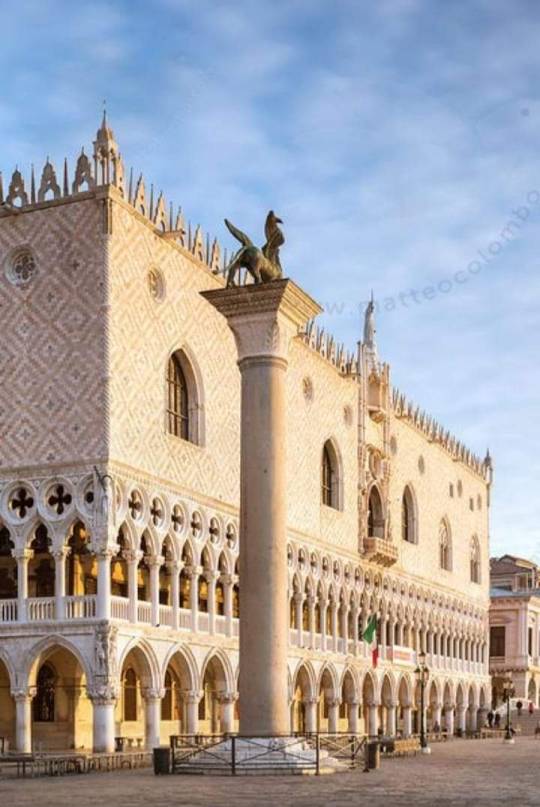
Doges Palace, Venice, ITALY
23 notes
·
View notes
Text
Isle of Doges (Venice part 2)

On the first morning of our first visit to Venice, the wisest thing to do was follow the crowd. We headed straight to St Mark's Square.
As soon as you get there, you understand why the piazza is so popular. It is lined on three sides by opulent Renaissance façades (pictured above).
On the fourth side stands a huge, and hugely ornate, church. Everything is white, except for a red-brick bell tower in the middle.
The sense of space is all the more striking as you emerge from busy alleys. Suddenly the company of fellow tourists no longer matters: you gasp in wonder, along with everyone else.
We had tickets for the Doge's Palace (Palazzo ducale). That landmark, I knew, was not sponsored by an American carmaker: it was named after the "doges", the men who ran Venice during its 1,000-year run as an independent republic.
But that was the extent of my knowledge. I wondered why the French call it "Palais des Doges" – in the plural. Was there just one or several of them in charge at any one time? How did you get the job? What was a doge's life like?
The answers lay within the Palazzo. First, though, we had to find the building.
It turned out to be located slightly off the square, wedged between the huge church and the waterfront. (The best view is from the canal: the palace is on the right of the picture below, which I took later, in the evening light.)

As you enter the courtyard, more gasping awaits.
At the far end stands the "Giants' Staircase", which leads up to the spot where doges were crowned.

The main structure was built around 1500. The statues of Mars and Neptune were added half a century later. Mere marble steps, apparently, were not grand enough for the occasion.
You enter the state rooms by walking past two other mythological hunks.
I find Hercules clobbering the Hydra particularly inspiring (on the left below).
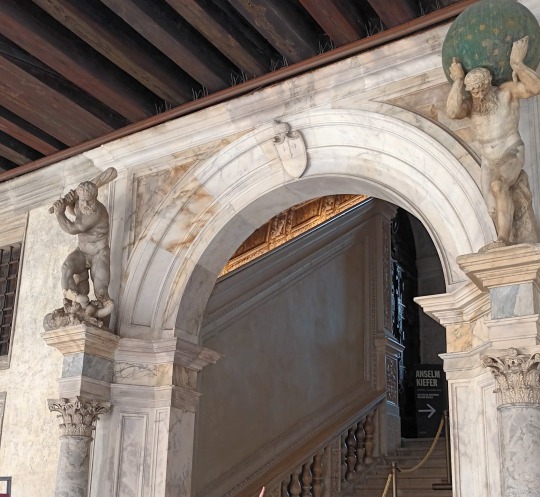
Then you're led up the grandmother of all stairways, the Scala d'Oro, also built in the middle of the 16th century.
Its appellation is not hyperbole: the ceiling is covered with gold.
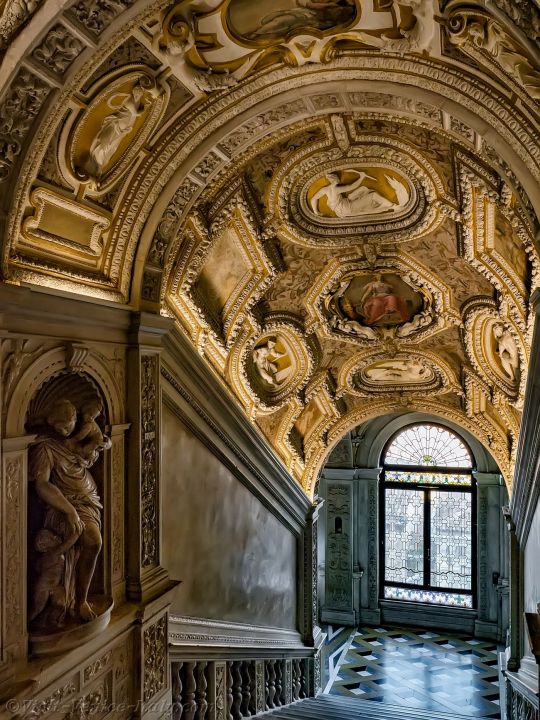
The Venetians liked to flaunt their wealth and taste. The Golden Staircase takes you to the Square Atrium, where foreign leaders were told to wait before being ushered into the formal chambers.
From the 1560s, they would have been staring at a carved ceiling decorated by Tintoretto.
The octagonal painting, a sign notes, depicts the doge of the day "humbly kneeling" before figures representing justice and peace.

Thus for Venetian grandees, "humility" consisted in being shown by Tintoretto as visited by the cardinal values of the republic.
The next few rooms are lined with more masterpieces.

A few more Tintoretto, including the Forge of Vulcan above, grace the Antecollegio, another anteroom (the Venetians obviously liked to keep their guests waiting but they did so in style).
The Sala Della Bussola (Compass Room) is described as yet another vestibule – this time reserved for those summoned by judges.
Everything was done to put defendants in the right frame of mind: on the ceiling Saint Mark is shown by Veronese playing Frisbee with the theological virtues:

Inspired as they were by ancient myths and Christian iconography, the artists didn't forget who their patrons were.
The Senate Hall features Tintoretto's “Dead Christ Adored” in which two doges witness the messiah’s final ascent. I seem to detect a hint of artistic sarcasm in their shifty look ("should really be here?").

The palace’s pièce de résistance adorns the Sala del Maggior Consiglio (Hall of the Great Council).
That hall could fit an Olympic-size swimming pool - and, thanks to global warming, is bound to turn into one some day.

The wall behind the doge's throne is fully occupied by Tintoretto's Paradiso. Measuring 22m end to end, it is the largest painting in the world - excepting daubs made for the Guinness Book of World Records.
It took old Tintoretto four years to complete. The 500-odd figures crowding the messiah include angels, archangels, apostles, saints and, of course, a roster of Venetian worthies.
John Ruskin, a notoriously fastidious critic, professed "no hesitation in asserting this picture to be by far the most precious work of art of any kind whatsoever, now existing in the world".
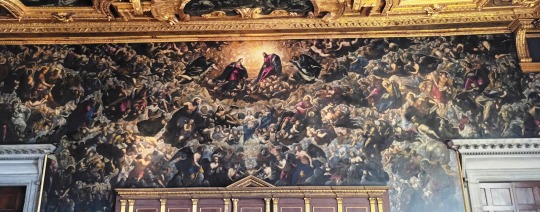
The Sala del Maggior Consiglio brings me to the initial object of our visit: the governance of republican Venice.
La Serenissima is best described as a patriarchal oligarchy. The Great Council was made up of all male adults from patrician Venetian families, irrespective of merit or wealth.
Although never a democracy, this was a form of a collective leadership and thus a bulwark against arbitrary rule. The last thing the nobles wanted was a tyrant.
It is worth quoting the explanatory sign at length on this point:
"In spite of the restrictions in its powers that the Senate introduced over the centuries, the Great Council continued to be seen as bastion of republican equality. The Council had the right to call to account all the other authorities and bodies of the State when it seemed that their powers were getting excessive and needed to be trimmed. The 1,200 to 2,000 noblemen who sat in the Council always considered themselves guardians of the laws that were the basis of all the other authorities within the State."
The council was regarded the fount of all legitimacy: its members elected the doges (one of them at a time, I found out) but also kept tabs on them. In the 14th century, one incumbent was beheaded for trying to set up a dictatorship.
Venice retained a large degree of collective rule for centuries – roughly until the Renaissance. During that period its achievements were formidable. It became the greatest Mediterranean power since Rome.
A technological and cultural innovator, it revolutionised glassmaking and shipbuilding; it invented the assembly line and double entry-bookkeeping; it pioneered globalisation (Max Weber, a German, argued that Protestant northern Europe was the cradle of capitalism: he was wrong.)
Over time, two developments occurred. The first was concentration of power. The daily administration of a growing empire could not be conducted by an assembly of 2,000 people.
The full Maggior Consiglio took a back seat while subcommittees were given various portfolios. In the 14th century, a 60-member Senate took charge of trade and foreign policy. A "Council of Forty" served as a supreme court.
Such specialisation was inevitable, but it led to an erosion of Venice’s brand of lineage-based egalitarianism. Some aristocrats became more equal than others. By the late 1400s, a "Council of Ten" set up to look after security started to watch over other government business.
The second development - decline - is linked to the first. It is a fact universally acknowledged that unchecked rule by insiders breeds decay and corruption.
From the 15th century, the city-state began to lose control of Asian trade routes; rival empires began nibbling away at its far-flung possessions.
Cultural atrophy ensued. The last major building work on the Piazza San Marco was undertaken in the 1580s. By then, the Venetian school of art was dying. The masterpieces in the Palazzo ducale are its swansong.
Incestuous elites managed La Serenissima's decline until 1797, when the last doge surrendered the city to a jumped-up French general (named Bonaparte) who plundered it.
1 note
·
View note
Photo

Venice at Night An original watercolour based on studies made from a vaporetto. Night scenes in watercolour are more challenging, however the results are worth it when you get it right. #vaporetto #venice #venezia #veniceatnight #dogespalace #watercolour #watercolourpainting #cityscapepainting (at Alan Reed Art) https://www.instagram.com/p/CgoUQQjIDRm/?igshid=NGJjMDIxMWI=
#vaporetto#venice#venezia#veniceatnight#dogespalace#watercolour#watercolourpainting#cityscapepainting
2 notes
·
View notes
Text

Au pays de l’amour
2 notes
·
View notes
Video
youtube
Bestravelvideo Venice, Italy: Doge’s Palace - Palazzo Ducale in 4K
3 notes
·
View notes
Text

19 notes
·
View notes
Text
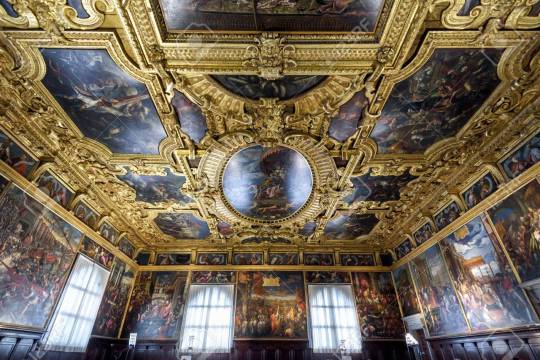


DOGE’S PALACE in ITALY
7 notes
·
View notes
Photo

Doge's view (by jeffbrian) San Marco, Venice, IT.
#landscape#travel#venice#italy#dogespalace#window#view#bay#dock#marina#boats#ocean#sea#shore#coast#curators on tumblr
97 notes
·
View notes
Photo

Doge's Palace, Venice, Italy
Instagram
#dogespalace#travel#doge's palace#italy#venice#architecture#beautiful#photography#travel photography#inspiration#travel inspiration#palace#italian#italian palace#italy travel#travel italy#italy inspiration#venetian#venetian palace#palazzo ducale#gothic#venetian gothic#gothic architecture#mine
41 notes
·
View notes
Text

I WON AT DOGE 2048!!! THIS IS MY GREATEST ACCOMPLISHMENT, BRO, I HAVE PEAKED!!
#doge 2048#doge#doge bloge#dogespalace#shibe doge#2048#i am the alpha doge#i might as well die now#for i have peaked#there is nothing that could take me higher#i have peaked
12 notes
·
View notes
Photo

Colonnade of Doges Palace inner court, Venice
#architecture#architecture drawing#drawing#perspective#perspective drawing#sketch#hand drawing#pen drawing#venice#italy#dogespalace
5 notes
·
View notes
Text

Doge’s Palace, Venice. This is such a beautiful place; I was in awe of the architecture and art. The heart of Venetian culture and politics. It’s a masterpiece of Gothic design. I loved looking out from the terrace onto Saint Mark’s plaza.
1 note
·
View note
